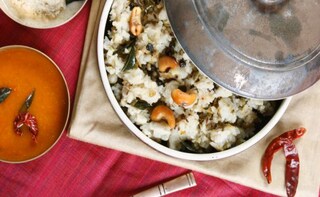My first memories of Pongal are synonymous with the ‘Pongal test match’ at the MA Chidambaram stadium. The Indian equivalent of the boxing day match when almost without exception, Chennai would host a visiting test team every January. A tradition that dates back almost 100 years when the Annual Indians vs Europeans Pongal match would always take place around the Pongal festival. Unlike Melbourne’s boxing day test, Chennai has lost this great tradition to India’s frenetic international schedules. But Chennai is hardly the place to celebrate Pongal - arguably the most important festival in the Tamil calendar. The real festivities take place in the state’s rural and fast expanding small towns.
Day four is a day of celebration and social visits. Kaanum (to see) Pongal takes its name from these visits when it’s common for families to jump on to their bullock carts (mostly tractors or other vehicles these days) and either call on relatives or congregate around rivers or temples and dig into their packed lunches. It’s the only day during the Pongal festivities when meat and seafood are cooked. A kuzhambu with karuvadu (dried fish) and pachai mochai (green beans) is a Kaanum Pongal special and so is a spinach dish cooked with drumstick leaves. Quite a few villages host a Pongal thiruvizha (carnival) while in the big cities everyone makes a beeline to parks and beaches. It’s also become a modern tradition across Tamil Nadu for people to catch the latest Pongal film releases on Kaanum Pongal. That’s one of the only changes in a festival with traditions that date back over a thousand years and one of the only four-day long thanksgiving ceremonies to nature anywhere in the world.Sakkarai Pongal
Recipe By Praveen Anand, Executive Chef, Crowne Plaza Chennai Adyar ParkIngredients:For the rice-dal mixture
1/4 cup raw rice
1/4 cup split yellow lentils
1 1/2 cups waterFor the jaggery mixture
1/2 cup jaggery
1/2 cup waterFor the tempering mixture
4 Tbsp ghee
2 Tbsp cashew nut
2 Tbsp raisinsFor the spice mixture
1/4 tsp cardamom powder
Cooking Method:1. Take quarter cup each of rice and yellow lentils and soak them in 1½ cups of water for 15 minutes. Cook the dal and rice together in a pressure cooker for 10 minutes on a low flame. Remove from heat and allow the pressure to release naturally. Set this aside.2. Take jaggery and boil it in water until the jaggery is melted. Remove from heat. Strain the boiled jaggery water on a muslin cloth. Set aside.3. Take a small pan and set it on a low flame. Add the ghee and the cashew nuts. Roast on low flame until lightly brown. Add the raisins and wait for it to plump up. Once it’s plumped up, remove from heat and transfer to a small bowl. Set aside.4. Mix the jaggery water and the cooked rice and dal mixture and set it on a stove on low flame. Keep stirring constantly. Let it simmer for 2-3 minutes. Add in the cardamom powder. Now add in the ghee and nut mixture and stir until all the ghee is absorbed into the pongal.5. Remove off heat and serve hot or at room temperature.About the Author:Ashwin Rajagopalan is a Chennai-based writer who writes on topics related to food, gadgets, trends and travel experiences. He enjoys communicating across cultures and borders in his weekday work avatar as a content and editorial consultant for a global major and one of India's only cross cultural trainers.Disclaimer:The opinions expressed within this article are the personal opinions of the author. NDTV is not responsible for the accuracy, completeness, suitability, or validity of any information on this article. All information is provided on an as-is basis. The information, facts or opinions appearing in the article do not reflect the views of NDTV and NDTV does not assume any responsibility or liability for the same.
Advertisement
Day four is a day of celebration and social visits. Kaanum (to see) Pongal takes its name from these visits when it’s common for families to jump on to their bullock carts (mostly tractors or other vehicles these days) and either call on relatives or congregate around rivers or temples and dig into their packed lunches. It’s the only day during the Pongal festivities when meat and seafood are cooked. A kuzhambu with karuvadu (dried fish) and pachai mochai (green beans) is a Kaanum Pongal special and so is a spinach dish cooked with drumstick leaves. Quite a few villages host a Pongal thiruvizha (carnival) while in the big cities everyone makes a beeline to parks and beaches. It’s also become a modern tradition across Tamil Nadu for people to catch the latest Pongal film releases on Kaanum Pongal. That’s one of the only changes in a festival with traditions that date back over a thousand years and one of the only four-day long thanksgiving ceremonies to nature anywhere in the world.
Advertisement
Recipe By Praveen Anand, Executive Chef, Crowne Plaza Chennai Adyar ParkIngredients:For the rice-dal mixture
1/4 cup raw rice
1/4 cup split yellow lentils
1 1/2 cups waterFor the jaggery mixture
1/2 cup jaggery
1/2 cup water
Advertisement
4 Tbsp ghee
2 Tbsp cashew nut
2 Tbsp raisinsFor the spice mixture
1/4 tsp cardamom powder
Cooking Method:1. Take quarter cup each of rice and yellow lentils and soak them in 1½ cups of water for 15 minutes. Cook the dal and rice together in a pressure cooker for 10 minutes on a low flame. Remove from heat and allow the pressure to release naturally. Set this aside.2. Take jaggery and boil it in water until the jaggery is melted. Remove from heat. Strain the boiled jaggery water on a muslin cloth. Set aside.
Advertisement
For the latest food news, health tips and recipes, like us on Facebook or follow us on Twitter and YouTube.
Advertisement
